Ever bite into a warm, fresh piece of bread and immediately regret it? No, it’s not just a food baby—it could be something more. If you’ve ever found yourself clutching your stomach and cursing that delicious piece of toast, you might be dealing with gluten sensitivity. Let’s dive into what this really means and how you can manage it with the right approach to eating.
What Is Gluten Sensitivity, Anyway?
Okay, let’s start from the top. Gluten is this sneaky little protein lurking in many grains like wheat, barley, and rye. It’s what gives dough that stretchy texture and bread its delightful chewiness. Magic, right? But for some folks, gluten isn’t just another ingredient. It’s a gut-wrenching (sometimes quite literally) nuisance.
Types of Gluten-related Disorders
Now, not all gluten-related issues are created equal. People often get confused between gluten sensitivity, celiac disease, and wheat allergies. Let’s break this down quickly:
- Celiac Disease: It’s an autoimmune disorder. Your body goes into full attack mode on your small intestine when you consume gluten. Serious stuff.
- Non-Celiac Gluten Sensitivity (NCGS): Not allergic, and doesn’t have the biomarkers of celiac, but gluten still causes discomfort. Think fatigue, bloating, and brain fog.
- Wheat Allergy: A total immune response to proteins in wheat but not specifically to gluten.
Understanding where gluten sensitivity fits can really shape the way you handle it moving forward.
Cozying Up with a Hormone Balancing Diet
Making some dietary changes could be life-changing. A hormone balancing diet can help manage those teetering blood sugar levels and could improve how your body reacts to food intolerances. Keeping your platelet spinning couldn’t be more essential when dealing with gluten sensitivity.
Here’s how focusing on your diet could smooth things out:

- Balanced Meals: Make sure your meals are a good mix of protein, healthy fats, and fiber-rich carbs. Think quinoa bowls with avocado and grilled chicken.
- Stable Blood Sugar: Regular meals and balanced components can help keep those insulin spikes in check. They’re not just annoying—they can spark cravings and invite mood swings. That jittery post-pasta sensation? Delayed energy release, my friend.
Funny thing, right? The less activity your insulin is doing, the more stable hormone levels you achieve and the healthier you feel. Who knew a simple plate of food could make such an impact on your entire day?
Gluten-Free Doesn’t Mean “Blah”
Cutting out gluten doesn’t mean you’re stuck with cardboard-flavored substitutes or endless salads. Trust me on this one—there are so many tasty options out there. Dive into your gluten-free health journey with an adventurous spirit!
Rediscovering the Kitchen: Allergy-Free Living
Let’s keep things real. A lot of emotions flare up when you say goodbye to gluten. Here’s a perspective shift—what about saying hello to a world of new tastes instead?
- Quinoa and Rice: Great grains, rich and filling. They don’t trigger gluten responses and can be spiced up in infinite ways.
- Gluten-Free Oats: Breakfast savior? You bet. Just make sure they’re certified gluten-free to avoid cross-contamination.
- Nuts and Seeds: For snacks beyond the forbidden breadsticks. They’re loaded with good fats and protein, perfect for a hormone balancing diet.
With a stocked pantry of these staples, you’re headed to flavorful meals without compromising on health or satisfaction.
Navigating Social Situations and Roadblocks
Social eating can feel like a national sport at times, right? Navigating gluten sensitivity doesn’t always mesh well with spontaneous dinner invites or office pizza parties, but you don’t have to miss out.
- Speak Up: Loving your food also means explaining your preferences or restrictions clearly. You aren’t being fussy—you’re taking care of yourself.
- Plan Ahead: Scout the menu before a restaurant visit. Many places have gluten-free options; it’s becoming wonderfully mainstream.
- BYO: Bring Your Own—be it a dish or a dessert when heading to foodie gatherings and potlucks. Seek a little of what you love without relying solely on others.
At first, it might feel like Meredith Grey-style life-altering change, but, with time, everyone will know your dietary needs as well as you do.

Common Mistakes to Sidestep
Going gluten-free for health reasons is daunting enough without tripping over common pitfalls. Keep your gluten sensitivity journey smooth by avoiding these oops moments:
Assuming All “Wheat-Free” is “Gluten-Free”
It seems obvious but nonetheless a classic newbie stumbling block. Wheat-free doesn’t automatically remove all gluten. Ingredient lists are a constant guide: always check twice!
Ignoring Labels
Sounds tedious, yet ingredient lists are going to be your new BFF. Processed foods carry the disguise of sneaky gluten often resting in binders or flavorings.
Going It Alone
There’s no trophy for attempting to do everything by yourself. Consulting a nutritionist or dietician can up your game, offering tailored advice and moral support. Besides, we are lifelong learners, and dietary education can only fortify your gluten-free health goals.
Overlooking Cross-Contamination
Kitchens are chaotic! For shared settings, cross-contamination is a real devious deal. Utensils or toasters harboring gluten particles are enough to make waves—designated gluten-free workspace areas can help dodge accidents marvelously.

Feeling more confident on circumventing these challenges? Good. Just know that every new challenge has a way around it with a little patience and creativity.
Recipe Ideas to Keep Your Taste Buds Happy
Quinoa and Veggie Stir-Fry
**Ingredients:**
- cup quinoa
- cups vegetable broth
- bell pepper, sliced
- zucchini, chopped
- cup broccoli florets
- onion, chopped
- tablespoons gluten-free soy sauce
- Sesame seeds (optional)
Cook up the quinoa in broth for added oomph. Stir-fry veggies, blend in quinoa, soy sauce, and sprinkle those seeds if you’re feeling fancy. Seriously satisfying!
Gluten-Free Oat and Banana Pancakes
**Ingredients:**
- ripe bananas, mashed
- eggs
- cup gluten-free oats
- tsp baking powder
- tsp vanilla extract
- Sweetener of choice (honey or maple syrup work great)
Blend everything until smooth, and cook in a non-stick pan till golden. Top with berries, nuts, or a drizzle of syrup. Simple enough for any morning logistical zombies, like yours truly.
Wrapping It Up: Your Gluten Sensitivity BFFs
Embracing gluten-free health isn’t a gloom-heavy sentence. It’s discovering a new normal that keeps you feeling amazing. Dive into high-fiber, low-glycemic oats. Bring your own dishes to social scenes. Get creative in the kitchen and ensure you nourish not just your body, but your senses.
Treat gluten sensitivity not as a limitation but as an opportunity. Whether you’re opting for hormone-friendly fare or joining the quinoa craze, every step and experiment is progress. It’s a bumpy road at first, but soon enough, you’ll find yourself driving smoothly toward gluten-free bliss. Adventure on—and embrace the journey toward a healthier you.
Frequently Asked Questions
What are the key components of a hormone-balancing diet?
A hormone-balancing diet typically includes a balance of healthy fats, quality proteins, and fiber-rich vegetables. It is important to consume foods that support hormone production, such as avocados, oily fish, and whole eggs, which are rich in healthy fats. Additionally, incorporating anti-inflammatory foods like turmeric, ginger, and dark leafy greens, as well as cruciferous vegetables for estrogen detoxification, is beneficial. The diet should also include slow-burn carbohydrates to maintain blood sugar stability and support adrenal and thyroid function[1][4][5>.
Which foods should I avoid to support hormone balance?
To support hormone balance, it is advisable to limit or avoid foods with excessive added sugar, alcohol, and processed foods. These can lead to inflammation, blood sugar imbalances, and hormone imbalances. For example, foods high in refined carbohydrates and sugar can spike insulin levels, while high-sugar foods can increase cortisol levels and lead to inflammation[1][2][5>.
How can a hormone-balancing diet improve my overall health?
A hormone-balancing diet can have several health benefits beyond just hormone regulation. It can enhance metabolic efficiency by boosting the body’s ability to burn calories, improve mood and energy levels by stabilizing hormones like estrogen and testosterone, and reduce the risk of chronic diseases such as type 2 diabetes and certain cancers. Additionally, it can support reproductive health, particularly for those with conditions like PCOS, and improve skin health by reducing inflammation[2][4][5>.
What specific foods are beneficial for hormone balance in women, especially those with PCOS?
For women, especially those with PCOS, foods like flaxseed, avocados, spinach, broccoli, and green tea are particularly beneficial. Flaxseed helps balance estrogen levels, avocados provide healthy fats for hormone production, spinach offers phytonutrients, broccoli supports liver and gut health, and green tea improves insulin sensitivity and blood sugar control. These foods can help reduce PCOS symptoms and support overall hormonal balance[5>.
References- MindBodyGreen. (2023). Hormone-Balancing Diet Tips: 11 Foods To Eat & Avoid.
- Frisco ER. (2024). Five Surprising Ways a Hormone Balancing Diet Improves Your Health.
- Plate and Canvas. (2023). The Best Diet for Hormone Balance: Everything You Need to Know.
- AZ GYN. (2024). Eating for Hormonal Balance: Foods to Incorporate into Your Diet.




